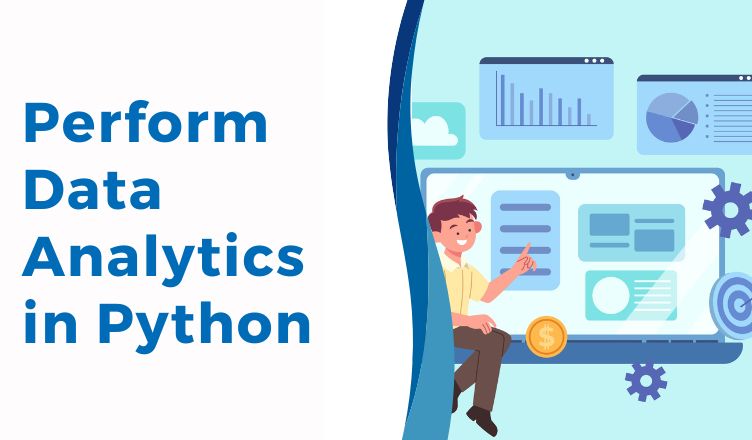In the digital world of today, data is present everywhere. We continuously produce enormous amounts of information, from our interactions on social media to our online buying habits. Making sense of it all and interpreting it are the only challenges. The human eye isn't even able to identify patterns and trends because millions of data points are generated every day.
Here's where data analysis comes into play. A would-be data analyst sorts through a ton of data using strong programming tools to extract valuable insights that are then utilized to help them make the best business decisions.
You will be guided step-by-step through the process of using Python for data analysis in this introductory blog. We start with an example of real life on how data analytics benefits individuals; then we continue with the associated code and resources to get one going.
Why Python for Data Analytics?
Here are some really good reasons you should keep Python handy for your needs:
- Rich Libraries: It offers a variety of libraries like Pandas, NumPy, Matplotlib, and Seaborn that help the development of data manipulation, analysis, and visualization.
- Community Support: With its broad community base, finding solutions and getting support for most queries about data is not hard.
- Integration: It's a great option for bespoke Python web development because it connects with other technologies rather effectively as well.
- Learning curve: The clear, simple syntax of Python makes it easier for analysts and developers to concentrate on problem-solving rather than the confusing nuances of the language.
Setting Up Your Environment:
Before you begin with data analytics, you will want to set up your Python environment. Here's how you do it:
- Install Python: Download and install Python from the official website. The Anaconda distribution is preferred for data analytics because it comes bundled with packages and tools you will need.
- Install Jupyter Notebook: Jupyter Notebook is a great tool for running Python code while documenting your analysis in a notebook. You may install it by using:
Pip install notebook
- Install Required Libraries: Use pip to install libraries such as Pandas, NumPy, Matplotlib, and Seaborn:
Pip install pandas numpy matplotlib seaborn.
Data Collection:
Data can come from anywhere - as a CSV file, from a database, or even from an API. For this walkthrough, we'll use a CSV file.
Import pandas as PD
# Load data
data = pd.read_csv('your_data_file.CSV)
Data Exploration:
After getting your data, you are now in the exploration step. This is a very important step as it tends to help understand the structure and content of the dataset.
- Preview Data:
print(data.head()) # Display the first 5 rows
- Summary Statistics:
print(data.describe()) # Get summary statistics
- Check for Missing Values:
print(data.isnull().sum()) # Count missing values
Data Cleaning:
Data Cleaning: This is the process to make sure your analysis quality is good. It may be handling missing values, correction of data type, and removal of duplicates.
# Drop missing values
data.drop a(inplace=True)
# Convert data types
data['date'] = pd.to_datetime(data['date'])
# Remove duplicate
data.drop_duplicates(inplace=True)
Data Analysis:
From there, you can perform a variety of analyses depending on your goals.
- Descriptive Analysis:
This encompasses summarizing the basic features of data. You can use Pandas to aggregate and group data.
# Group by a categorical variable
summary = data. group by('category').agg({'sales': 'sum', 'quantity': 'mean'})
print(summary)
- Visualization:
Data visualization is really useful in better interpretation of results. Libraries such as Matplotlib and Seaborn are good for this.
import matplotlib.pyplot as plt
Import seaborn as sns
# Basic line plot
plt.figure(figsize=(10, 6))
plt.plot(data['date'], data['sales'])
plt.title('Sales Over Time)
plt.label('Date')
plt.label('Sales')
plt.show()
# Bar plot
sns.barplot(x='category', y='sales', data=data)
plt.title('Sales by Category')
plt.show()
- Advanced Analysis:
There's much more advanced analysis one can achieve with libraries like Scikit-learn for machine learning or Statsmodels to do statistical analysis.
- Predictive Analytics:
Predictions about future trends can be made in models by using machine learning.
From sklearn.model_selection import train_test_split
from sklearn.linear_model import LinearRegression
# Prepare data
X = data[['feature1', 'feature2']]
y = data['target']
# Split data
X_train, X_test, y_train, y_test = train_test_split(X, y, test_size=0.2, random_state=42)
# Train the model
model = LinearRegression()
model.fit(X_train, y_train)
# Make predictions
predictions = model.predict(X_test)
Conclusion:
Data analytics in Python proves to be a very powerful way of extracting insights from data to make informed decisions. For companies interested in utilizing Python development services in India, partnering with a custom web development service like Tuvoc Technologies would serve to present an enhancement for your data analytics capabilities.
By referring to this guide, you will be very well set to carry out effective data analytics in Python. In this regard, it matters little whether you are a veteran developer or a newcomer: the possibilities of using Python for data analytics are staggering and open doors to innovation and better business outcomes.
If you wish to know more or hire Python developers in India, please feel free to contact Tuvoc Technologies - a Custom Python Web development company for customized Python solutions designed to satisfy your business needs.





Comments